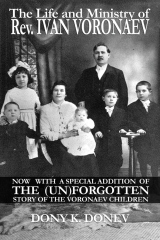Dony Donev: The Life and Ministry of Rev. Ivan Voronaev
 Dony K. Donev, The Life and Ministry of Rev. Ivan Voronaev: Now with a Special Addition of the (Un)Forgotten Story of the Voronaev Children (Spasen Publishers, 2011), 72 pages, ISBN 1477496939.
Dony K. Donev, The Life and Ministry of Rev. Ivan Voronaev: Now with a Special Addition of the (Un)Forgotten Story of the Voronaev Children (Spasen Publishers, 2011), 72 pages, ISBN 1477496939.
Dony Donev has provided a rare glimpse into the life of purportedly one of the most influential early Pentecostal church planters in Eastern Europe and Russia whose name was (at one point) “Ivan Voronaev” (among other forms and variants). This volume is neatly divided into two sections: first, the story of Voronaev; second, the story of his children. Each of these sections represent a paper presented at the Society for Pentecostal Studies and have conveniently found their place joined together into this volume. While this is not a typical biography it still offers personal insights drawn from letters and family interviews which provide a glimpse into the work of this missionary pastor.
Several things which would have helped this work better communicate Voronaev’s story: further editing, maps tracing the proposed journeys of Voronaev as well as possible explanations or clarifications for those less familiar with names of cities pre-WWII. Also, while the numerous pictures at the end of the volume are helpful and such things included in a historical piece are always welcome, they would likely be more helpful if the images were cleaned up for clearer viewing of names in any future revision.

Dony K. Donev is a regular contributor to PneumaReview.com.
Donev’s work is easy to read and well-documented throughout even when he surmises potential motivations for certain events. His writing style is enjoyable to read though it would be great to find him expounding on the various phases of Voronaev’s work further to create a more personal engagement with Voronaev. Of particular interest is the seemingly controversial account of Voronaev’s children that is provided in the second section of this volume. Donev attempts to steer an objective course in his portrayal of the account/s of the children though the controversies have a way of finding inclusion as influencing his tales. Some of this is a given when dealing with personal accounts that are emotionally charged.
The numerous pictures and letters add tremendous value to his work by offering a view of some of the original documents referred to elsewhere. Perhaps he might also consider mentioning the respective picture in the writing proper for better cross-referencing in future printings.
Category: Church History, Summer 2014


